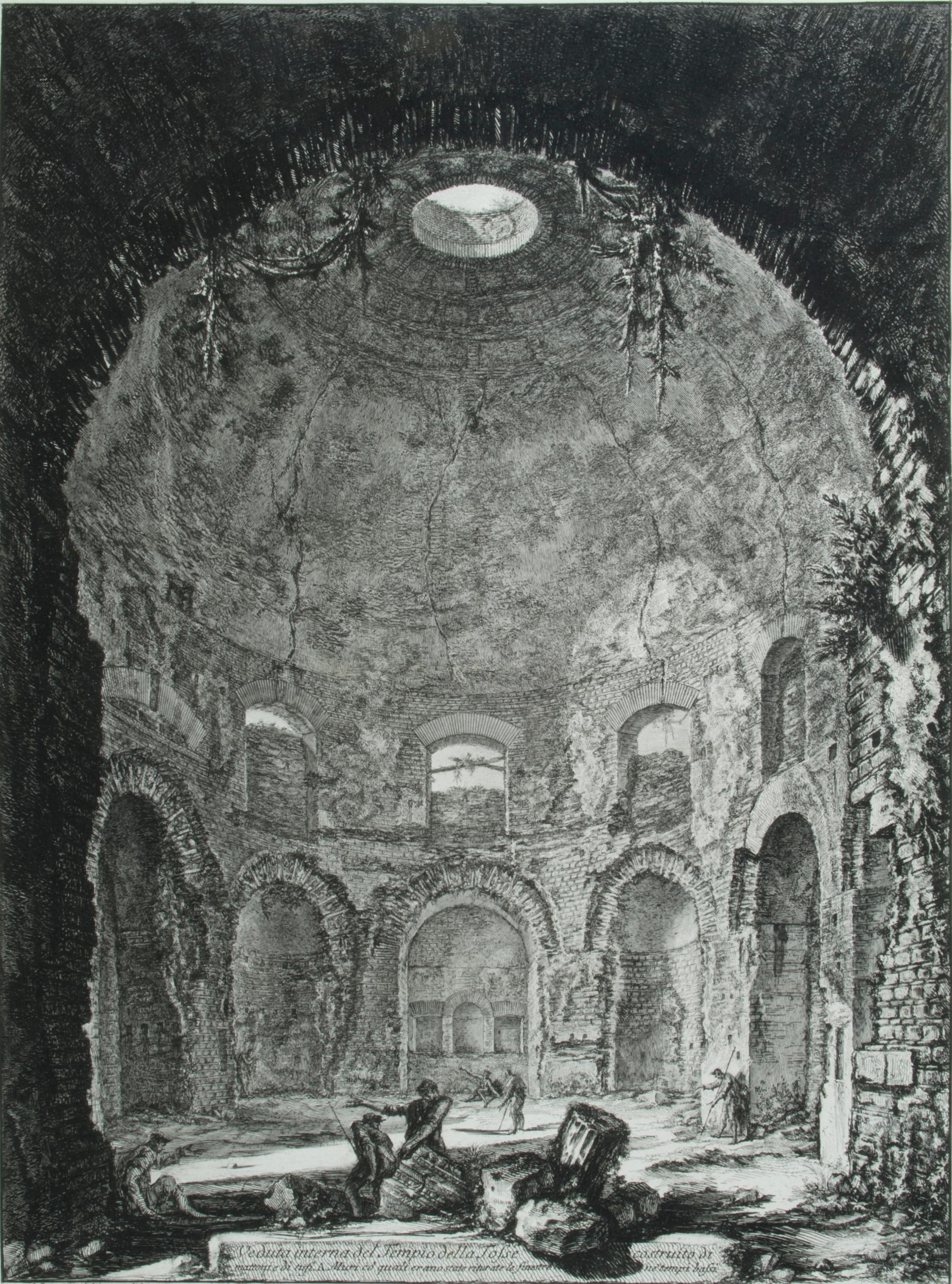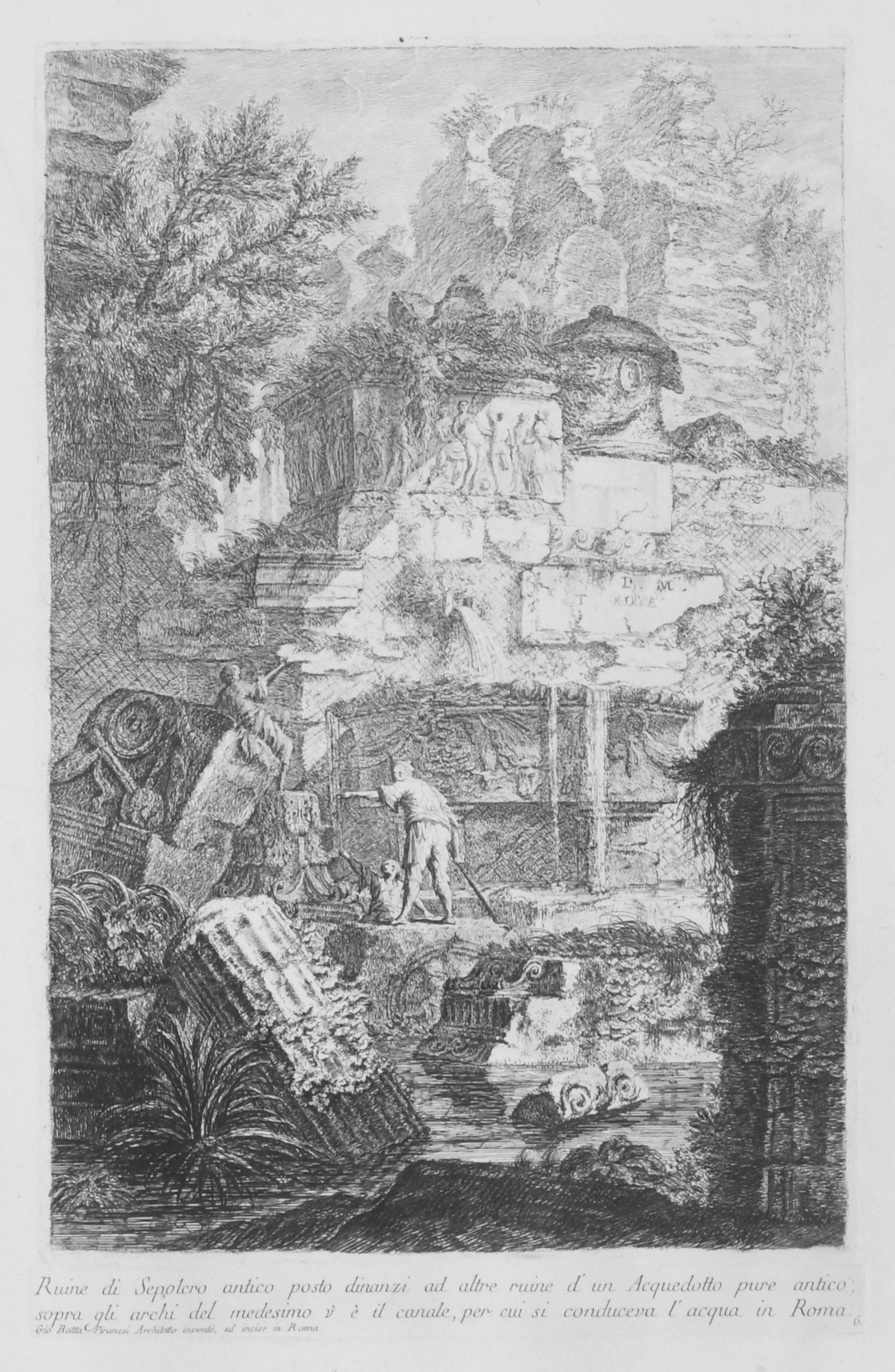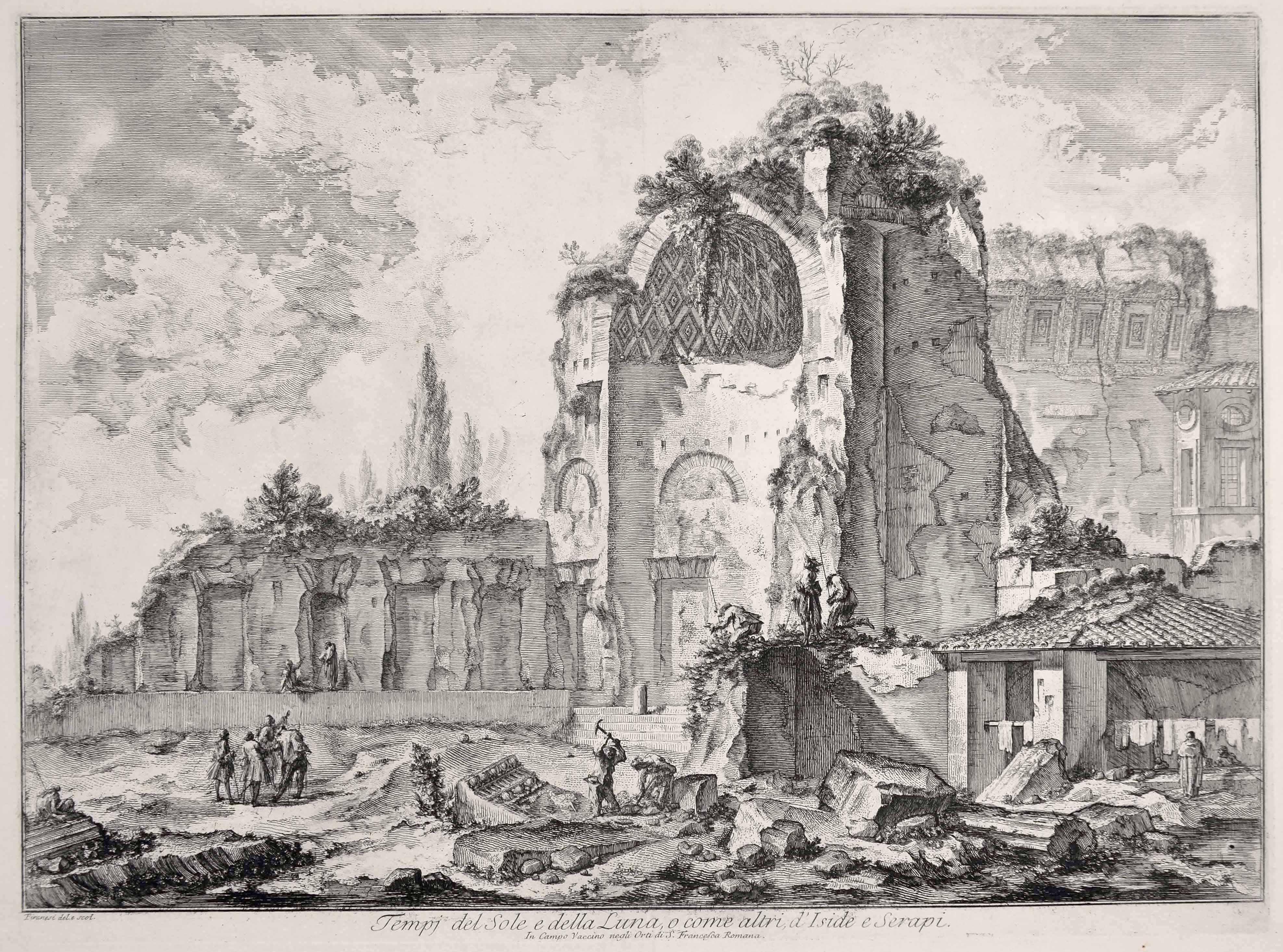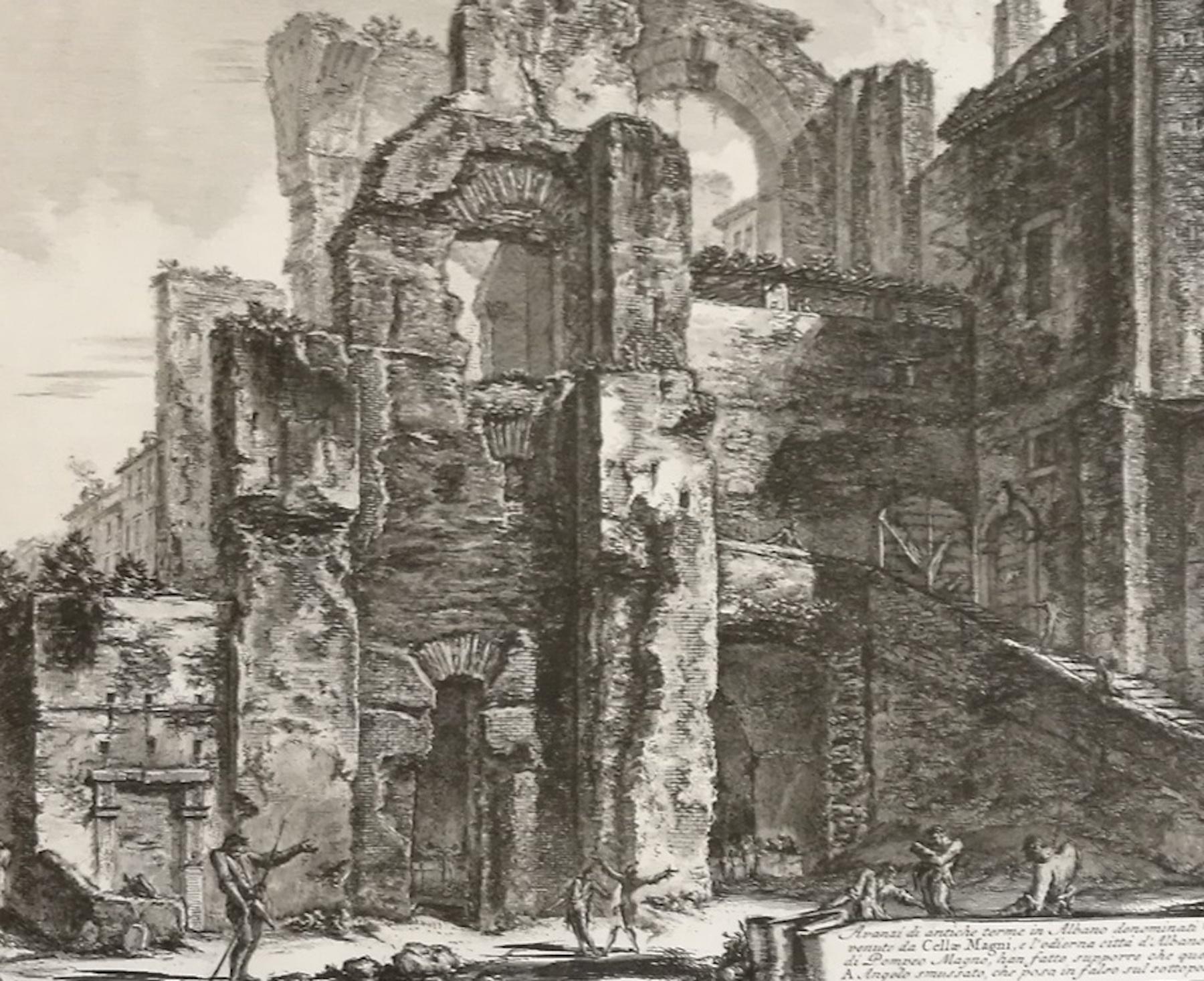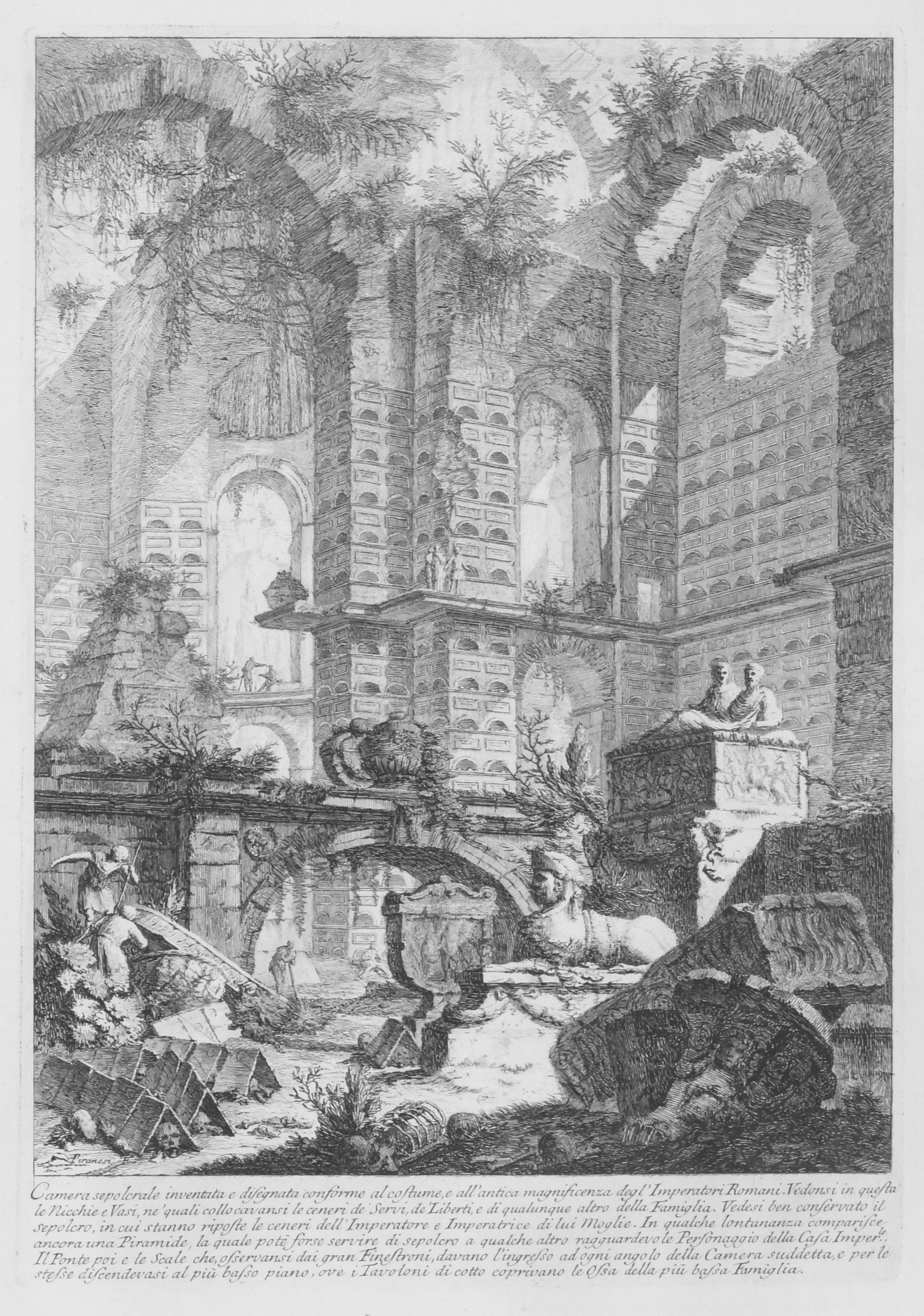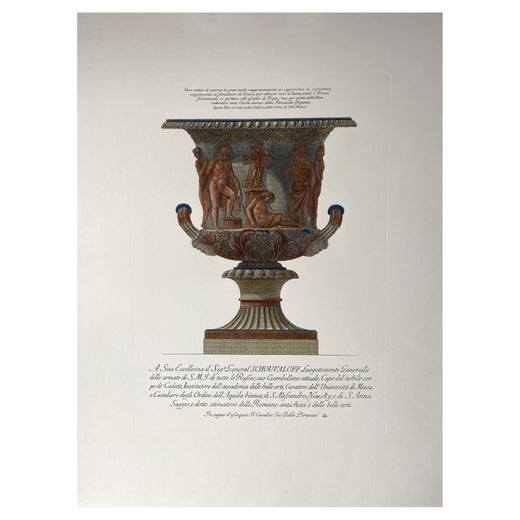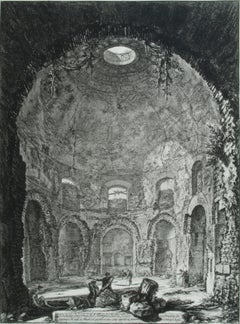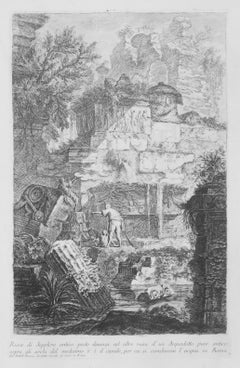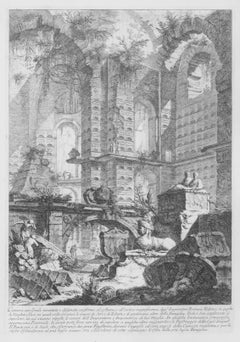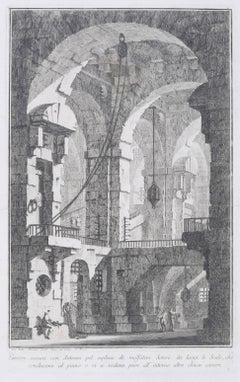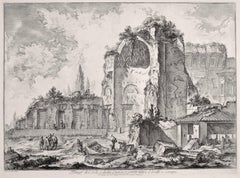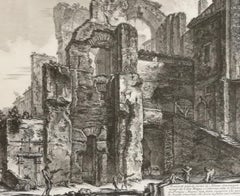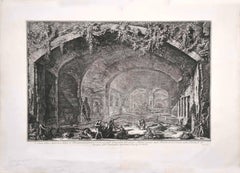Items Similar to The So-Called Tempio della Tosse, Near Tivoli. Interior Upright
Want more images or videos?
Request additional images or videos from the seller
1 of 9
Giovanni Battista PiranesiThe So-Called Tempio della Tosse, Near Tivoli. Interior Upright1764
1764
$2,750
£2,107.19
€2,423.77
CA$3,931.50
A$4,270.32
CHF 2,260.78
MX$51,561.51
NOK 28,223.53
SEK 26,737.31
DKK 18,098.06
About the Item
The So-Called Tempio della Tosse, Near Tivoli. Interior Upright (Veduta interna del Tempio della Tosse)
"Temple of the Cough"
Etching, 1764
Signed in the plate
From: Vedute di Roma, Plate 118
A Roman edition
Watermark: Fleur-de-Lys in a double circle
This building was depicted in a watercolor by J.M.W. Turner, 1819
Condition: Good/Excellent condition
Centerfold (as usual for Piranesi print from albums)
Bright snappy impression
Plate/Image size: 24 3/4 x 18 1/4 inches
Referrences: Focillon 775
Wilton_Ely 203
Hind 70 ii/V
"the so-called Tempio della Tosse (Temple of the Cough), believed to be the vestibule of a Roman villa. The ruin is situated near the Santuario di Ercole Vincitore (Sanctuary of Hercules Victor), formerly known as the Villa of Maecenas"
Courtesy: Tate
Regarding Vedute di Roma
"By 1747, Piranesi had begun work on the Vedute di Roma, and he continued to create plates for this series until he died in 1778. Piranesi’s Vedute, which overshadowed competitor’s views of Roman landmarks through compelling compositions, strong lighting contrasts, and dramatic presentation, shaped European conceptions of present day Rome. This influenced European thought to such an extent that Grand Tourists, who had come to know Rome through Piranesi’s prints, were recorded as being disappointed on their first encounter with the real thing.39 The views were intended as tourist souvenirs and, from their instant popularity, Piranesi had obviously judged the market well. His early sites include obvious popular sights, such as Piazza della Rotonda and the Sepolcro di Cecilia Metella. The first thirty-four views were published in a single volume and entitled Le Magnificenze di Roma. In his first views, the monument or subject was drawn from a distance so that it was clearly set in its context. The little figures present at the ground level are the everyday people and visitors in contemporary Rome. As represented in the “Veduta della Piazza della Rotonda,” Piranesi, clearly contorting perspective, etched an exaggerated and extended view of the Rotonda, unfocused on a specific aspect of the scene. His later views featured heavier line, a sublime eye, and more dramatic perspectives. They also specifically concentrate on a monument, like the “Veduta del Ponte Salario,” or ruin instead of portraying a sweeping view of Roman landscape. These changes could possibly be a response to market demand and what Grand Tourists wanted to see in their vedute, or it could be a personal style change as Piranesi became intrigued by the idea of the sublime. Nevertheless, these views of Rome firmly established Piranesi’s reputation and gave him the initial financial stability that enabled him to tackle grander themes. Moreover, Piranesi’s interest in ruins was genuine antiquarian desire to preserve and record.40 Piranesi was able to focus in on his awareness of what was noble and magnificent and gain a sense for the sublime in the architectural tradition of Rome. Piranesi’s lifelong obsession with architecture, past and present, was fundamental to his genius. His etched plates contained remarkable imagination and a practical understanding of ancient technology. They created a perception of antiquity lasting to our own time."
Courtesy Wellesley University
- Creator:Giovanni Battista Piranesi (1720-1778, Italian)
- Creation Year:1764
- Dimensions:Height: 24.75 in (62.87 cm)Width: 18.25 in (46.36 cm)
- Medium:
- Movement & Style:
- Period:1760-1769
- Condition:
- Gallery Location:Fairlawn, OH
- Reference Number:Seller: FA116461stDibs: LU14016034502
Giovanni Battista Piranesi
Piranesi was born in Venice in 1720 and died in Rome in 1778. He was the son of a stone mason and was trained as an architect. After a slow start he eventually achieved great success as an architect, archaeologist, artist, designer, collector, and antiquities dealer. His mission was to glorify the architecture of ancient Rome through his engravings and etchings. His highly dramatized prints often depict imaginary interiors and frequently include figures in mysterious activities, who are dwarfed by the magnitude of their monumental surroundings. Piranesi's style greatly influenced the neoclassical art movement of the late 18th century. His dramatic scenes inspired generations of set designers, as well as artists, architects and writers. His prints have continued to increase in value to institutions and collectors.
About the Seller
5.0
Recognized Seller
These prestigious sellers are industry leaders and represent the highest echelon for item quality and design.
Platinum Seller
Premium sellers with a 4.7+ rating and 24-hour response times
Established in 1978
1stDibs seller since 2013
815 sales on 1stDibs
Typical response time: <1 hour
Associations
International Fine Print Dealers Association
- ShippingRetrieving quote...Shipping from: Akron, OH
- Return Policy
Authenticity Guarantee
In the unlikely event there’s an issue with an item’s authenticity, contact us within 1 year for a full refund. DetailsMoney-Back Guarantee
If your item is not as described, is damaged in transit, or does not arrive, contact us within 7 days for a full refund. Details24-Hour Cancellation
You have a 24-hour grace period in which to reconsider your purchase, with no questions asked.Vetted Professional Sellers
Our world-class sellers must adhere to strict standards for service and quality, maintaining the integrity of our listings.Price-Match Guarantee
If you find that a seller listed the same item for a lower price elsewhere, we’ll match it.Trusted Global Delivery
Our best-in-class carrier network provides specialized shipping options worldwide, including custom delivery.More From This Seller
View AllThe So-Called Tempio della Tosse, Near Tivoli. Interior Upright
By Giovanni Battista Piranesi
Located in Fairlawn, OH
The So-Called Tempio della Tosse, Near Tivoli. Interior Upright (Veduta interna del Tempio della Tosse)
"Temple of the Cough"
Etching, 1764
Signed in the plate
From: Vedute di Roma...
Category
1760s Old Masters Interior Prints
Materials
Etching
Ruine di Sepolcro antico
By Giovanni Battista Piranesi
Located in Fairlawn, OH
Ruine di Sepolcro antico
Etching, 1743
Signed in the plate bottomleft in the caaption plate
From: Prima Parte, 1743
Second edition: 1750-1778
Watermark: R 37-39
A lifetime impression printed during Piranesi’s life, before the plates are moved to Paris by his sons in the 1790’s
Coniditon: Excellent/Very good
Image size: 14 5/8 x 9 3/4 inches
Reference: Robison 17 iii/V
Piranesi In Rome: Prima Parte di Architetture e Prospettive
"Although Piranesi studied architecture in Venice, he never was able to find work in the field other than a few jobs involving remodeling in Rome. While Piranesi was struggling to support his architectural endeavors upon his arrival in Rome in 1740, he spent a short period of time in the studio of master painter Giovanni Battista Tiepolo (1696-1770) in addition to his apprenticeship with Giuseppe Vasi. The first production of Piranesi’s early years in Rome and a culmination of his training under Vasi, Tiepolo, and his uncle, was the Prima Parte di Architetture e Prospettive (1743). The Prima Parte was a collection of twelve etchings of imaginary temples, palaces, ruins, and a prison. During this time, Piranesi was still developing the unique style of etching he is known for today, and as such the Prima Parte differs significantly in technique compared to later works. In the Frontispiece of the Prima Parte, Piranesi’s lines are definite and exact with very little flow to them, designed in the form of traditional etching. The detail is immaculate, and yet perspective of the piece is oddly simple and familiar to the viewer. Piranesi’s technique employs miniscule markings and lines, intricately woven together to create a stippling effect. The Prima Parte, described as “rigid” by art historian Jonathan Scott, came to be seen as a stark contrast to his later sketches, which were much lighter and freer. Influenced by the style of Tiepolo, which epitomized the lightness and brightness of the Rococo period, Piranesi adopted some of the more painterly techniques of the masters he apprenticed under. Piranesi made the medium of etching appear as though it was a sketch or a painting, hence a “freer” and more fluid design in his later works. For example, the frontispiece of the Prima Parte read as an etching to Piranesi’s audience, but in his later vedute, the style of etching almost appears to be made of brushstrokes. Moreover, at the same time Piranesi was working on the Prima Parte, he aided the artist Giambattista Nolli. There is a small section of Nolli’s map...
Category
1740s Old Masters Interior Prints
Materials
Etching
Camera sepolcrale
By Giovanni Battista Piranesi
Located in Fairlawn, OH
Camera sepolcrale
Etching 1743
Signed in the bottom left corner
From: Prima Parte, 1743
Second edition: 1750-1778
Watermark: R 37-39
A lifetime impression printed during Piranesi’s life, before the plates are moved to Paris by his sons in the 1790’s
Condition: Excellent
Image size: 14 5/8 x 9 3/4 inches
Reference: Robison 20 iii/V
Piranesi In Rome: Prima Parte di Architetture e Prospettive
"Although Piranesi studied architecture in Venice, he never was able to find work in the field other than a few jobs involving remodeling in Rome. While Piranesi was struggling to support his architectural endeavors upon his arrival in Rome in 1740, he spent a short period of time in the studio of master painter Giovanni Battista Tiepolo (1696-1770) in addition to his apprenticeship with Giuseppe Vasi. The first production of Piranesi’s early years in Rome and a culmination of his training under Vasi, Tiepolo, and his uncle, was the Prima Parte di Architetture e Prospettive (1743). The Prima Parte was a collection of twelve etchings of imaginary temples, palaces, ruins, and a prison. During this time, Piranesi was still developing the unique style of etching he is known for today, and as such the Prima Parte differs significantly in technique compared to later works. In the Frontispiece of the Prima Parte, Piranesi’s lines are definite and exact with very little flow to them, designed in the form of traditional etching. The detail is immaculate, and yet perspective of the piece is oddly simple and familiar to the viewer. Piranesi’s technique employs miniscule markings and lines, intricately woven together to create a stippling effect. The Prima Parte, described as “rigid” by art historian Jonathan Scott, came to be seen as a stark contrast to his later sketches, which were much lighter and freer. Influenced by the style of Tiepolo, which epitomized the lightness and brightness of the Rococo period, Piranesi adopted some of the more painterly techniques of the masters he apprenticed under. Piranesi made the medium of etching appear as though it was a sketch or a painting, hence a “freer” and more fluid design in his later works. For example, the frontispiece of the Prima Parte read as an etching to Piranesi’s audience, but in his later vedute, the style of etching almost appears to be made of brushstrokes. Moreover, at the same time Piranesi was working on the Prima Parte, he aided the artist Giambattista Nolli. There is a small section of Nolli’s map...
Category
1740s Old Masters Interior Prints
Materials
Etching
Carcere ascura
By Giovanni Battista Piranesi
Located in Fairlawn, OH
Carcere ascura
Etching, 1743
Signed in the plate bottom left corner
From: Prima Parte, 1743
Second edition: 1750-1778
Watermark: R 37-39
A lifetime impression printed during Piranesi’s life, before the plates are moved to Paris by his sons in the 1790’s
This image foretells Piranesi's famous set, Carceri (Prisons) which is his next creative effort.
Condition: Horizontal crease midway in the sheet associated with the manufacture of the paper.
Visible watermark verso
Small printer crease in the bottom right below the caption plate.
Image size: 14 1/2 x 9 1/2 inches
Reference: Robison 3 iii/VI
Piranesi In Rome: Prima Parte di Architetture e Prospettive
"Although Piranesi studied architecture in Venice, he never was able to find work in the field other than a few jobs involving remodeling in Rome. While Piranesi was struggling to support his architectural endeavors upon his arrival in Rome in 1740, he spent a short period of time in the studio of master painter Giovanni Battista Tiepolo (1696-1770) in addition to his apprenticeship with Giuseppe Vasi. The first production of Piranesi’s early years in Rome and a culmination of his training under Vasi, Tiepolo, and his uncle, was the Prima Parte di Architetture e Prospettive (1743). The Prima Parte was a collection of twelve etchings of imaginary temples, palaces, ruins, and a prison. During this time, Piranesi was still developing the unique style of etching he is known for today, and as such the Prima Parte differs significantly in technique compared to later works. In the Frontispiece of the Prima Parte, Piranesi’s lines are definite and exact with very little flow to them, designed in the form of traditional etching. The detail is immaculate, and yet perspective of the piece is oddly simple and familiar to the viewer. Piranesi’s technique employs miniscule markings and lines, intricately woven together to create a stippling effect. The Prima Parte, described as “rigid” by art historian Jonathan Scott, came to be seen as a stark contrast to his later sketches, which were much lighter and freer. Influenced by the style of Tiepolo, which epitomized the lightness and brightness of the Rococo period, Piranesi adopted some of the more painterly techniques of the masters he apprenticed under. Piranesi made the medium of etching appear as though it was a sketch or a painting, hence a “freer” and more fluid design in his later works. For example, the frontispiece of the Prima Parte read as an etching to Piranesi’s audience, but in his later vedute, the style of etching almost appears to be made of brushstrokes. Moreover, at the same time Piranesi was working on the Prima Parte, he aided the artist Giambattista Nolli. There is a small section of Nolli’s map...
Category
1740s Old Masters Interior Prints
Materials
Etching
S. Paolo Fuori Le Mura (Vedute della Basilica di S. Paolo fuor della mura)
By Giovanni Battista Piranesi
Located in Fairlawn, OH
S. Paolo Fuori Le Mura (Vedute della Basilica di S. Paolo fuor della mura)
Etching, 1748
From: Vedute di Roma, Plate 8
An early Roman printing, published by Bouchard e Gravier
Watermark: Fleur de Lys in a double circle
Signed in the plate
Condition: Small margins as are common with Bouchard published impressions.
Centerfold (as usual)
Rich impression with good contrasts
Plate/Image size: 15 7/8 x 24 1/8 inches
Sheet size: 17 3/8 x 24 3/4 inches
Reference: Focillon 723
Wilton-Ely 138
Hind 6 ii/VI, Bouchard e Gravier printing, before the price and numbers in later states
This image is Piranesi’s second interior scene from the Vedute di Roma. The first interior is a less complex composition of the Interior of St. Peters which lacks the challenging perspective that the artist masters in this image.
The Papal Basilica of St. Paul Outside the Walls...
Category
1740s Old Masters Interior Prints
Materials
Etching
XXXIII Fig. I Avanzo del Tempio di Castore e Polluce
By Giovanni Battista Piranesi
Located in Fairlawn, OH
XXXIII Fig. I Avanzo del Tempio di Castore e Polluce .View of the Remains of the Peristyle of the House of Nero,
Etching, 1756
Signed in the plate (see photo)
From: Le Antichità Roma...
Category
1750s Old Masters Landscape Prints
Materials
Etching
You May Also Like
Veduta della Spelonca, detta il Bergantino - Etching by G. B. Piranesi - 1762
By Giovanni Battista Piranesi
Located in Roma, IT
Veduta della Spelonca, detta il Bergantino is an original etching realized by G. B. Piranesi in 1762.
Image Dimensions: 43 x 63 cm
Very good condition.
Ref. Ficacci., p.442
Category
1760s Landscape Prints
Materials
Etching
Temples of Iside and Serapi - Etching by G. B. Piranesi - 1759
By Giovanni Battista Piranesi
Located in Roma, IT
Temples of Iside and Serapi is an etching realized by the italian artist Giovanni Battista Piranesi in 1759.
Image dimensions: 41.5 x 55.5 cm.
Very precious lifetime impression. C...
Category
1750s Figurative Prints
Materials
Etching
Avanzi di Antiche Terme in Albano denominate Cello Mano - by G. B. Piranesi
By Giovanni Battista Piranesi
Located in Roma, IT
Image dimensions 40.5x60.5 cm.
Ancient Baths in Albano called Cello Majo is an etching, drypoint and burin on laid and watermarked paper (lily in a double cercle).
Wonderful Specimen of a Roman antique edition. From the series of Piranesi’s etchings “Antichità di Albano e di Castel Gandolfo...
Category
1760s Landscape Prints
Materials
Etching
View of the Cave known as Bergantino - Etching by G. B. Piranesi - 1762
By Giovanni Battista Piranesi
Located in Roma, IT
View of the Cave known as Bergantino is an etching realized by the italian artist Giovanni Battista Piranesi in 1762.
Very precious and rare lifetime impression. Roman edition.
C...
Category
1750s Old Masters Figurative Prints
Materials
Etching
Church of St. Costanza, Rome: An 18th Century Piranesi Architectural Etching
By Giovanni Battista Piranesi
Located in Alamo, CA
This is a framed 18th century Giovanni Battista Piranesi etching entitled: "Veduta interna del Sepocro di Santa Costanza, fabbricat...
Category
1770s Old Masters Interior Prints
Materials
Etching
Ruins of an Ancient Tomb - G. B. Piranesi - 1762
By Giovanni Battista Piranesi
Located in Roma, IT
Ruins of an Ancient Tomb is an original etching realized by the italian artist Giovanni Battista Piranesi in 1762.
Image dimensions: 41.5x56 cm
Very precoius and rare lifetime spec...
Category
1760s Old Masters Figurative Prints
Materials
Etching
More Ways To Browse
Vestibule Antique
Veduta Del Ponte
Shaker Stove
Sleeping Beauty 1959 Lobby Card
Waiting For The Boys
Benjamin Buckley
C Riom
Charles Fazzino 3 D
David Hockney Rue De Seine
Desire Guilmard
Dial M For Modern
Frank Z
Harpers Weekly Framed
Kandinsky Lithograph Signed
Masahiro Arai On Sale
Piranesi Pantheon
Ralph Kerstner
Richard Conn
